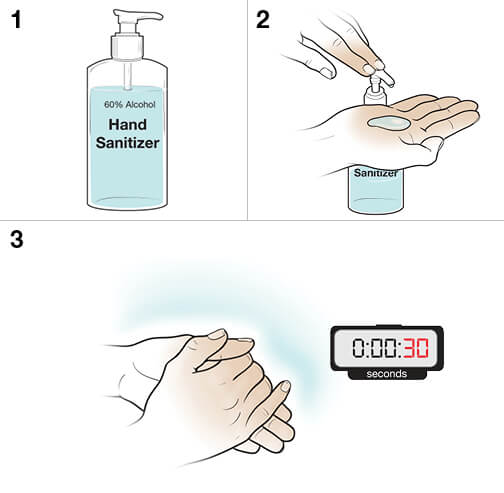Hand Sanitizer

Hand sanitizer, also known as hand antiseptics, hand rubs or hand massages, are applied to the hands to remove common pathogens (disease-causing organisms). Hand sanitizers are usually available in foam, gel or liquid form. Its use is recommended if soap and water are not available for washing hands or if repeated washing of the hand affects the natural skin barrier (e.g. dandruff or cracks in the skin). Although the effectiveness of hand disinfectants varies, it is used as a simple means of controlling infections in a variety of environments, from daycare centers and schools to hospitals and health clinics to supermarkets and cruise ships.
Types Of Hand Sanitizers

Depending on the active ingredient used, hand sanitizers can be divided into two types: alcohol-based or alcohol-free. Alcohol-based products typically contain between 60 and 95 percent alcohol, usually in the form of ethanol, isopropanol, or n-propanol. At these concentrations, alcohol immediately denatures proteins and effectively neutralizes certain types of microorganisms. Non-alcoholic products are generally based on disinfectants such as benzalkonium chloride (BAC) or on antimicrobial agents such as triclosan. The activity of disinfectants and antimicrobials is both immediate and persistent. Many hand disinfectants also contain plasticizers (e.g. glycerin) that soothe the skin, thickeners and fragrances.
Effectiveness

The effectiveness of the hand sanitizer depends on several factors, including the manner in which the product is used (e.g. amount used, duration of exposure, frequency of use) and whether the specific infectious agents that are present on the person’s hands for the active ingredient are vulnerable in the product. In general, alcohol-based hand disinfectants, if rubbed thoroughly over the surface of fingers and hands for 30 seconds and then fully air-dried, can effectively reduce the populations of bacteria, fungi, and some enveloped viruses (e.g., influenza A viruses) ). Similar effects have been reported for certain non-alcoholic formulations such as SAB hand sanitizer (surfactant, allantoin and BAC). However, most hand sanitizers are relatively ineffective against bacterial spores, non-enveloped viruses (e.g. norovirus) and encrypted parasites (e.g. Giardia). They also do not completely clean or disinfect the skin if the hands are noticeably dirty before use.

Despite the different effectiveness, hand sanitizers can help control the transmission of infectious diseases, especially in environments where washing hands is poor. For example, in elementary school children, the inclusion of an alcohol-based or an alcohol-free hand sanitizer in hand hygiene programs in the classroom has been associated with a reduction in absenteeism related to infectious diseases. In the workplace, the use of alcohol-based hand sanitizer has also been linked to a reduction in sickness episodes and sick days. In hospitals and health clinics, improved access to alcohol-based hand disinfectants has been associated with general improvements in hand hygiene.
Safety Concerns

Agencies such as the World Health Organization and the United States’ disease control and prevention centers promote the use of alcohol-based hand disinfectants over non-alcoholic products. In fact, the use of non-alcoholic products has been limited in part due to the WHO and WHO CDC focuses on alcohol-based products, but also concerns about the safety of chemicals used in non-alcoholic products. Research has shown that certain antimicrobial compounds, such as triclosan, can impair the function of the endocrine system. Another problem is triclosan pollution. Disinfectants and antimicrobials may also contribute to the development of antibiotic resistance. In 2014, growing concerns about triclosan prompted authorities in the European Union (EU) to restrict the use of chemicals in various consumer products in the EU.
In comparison, concerns about the use of alcohol-based hand disinfectants focused primarily on the flammability and ingestion of products, both unintentionally (e.g. by young children) and deliberately (by people who wish to abuse alcohol). With proper storage and strategies that restrict access to alcohol-based disinfectants (e.g., hand disinfectants to individuals), the risk of fire or poisoning from accidental or deliberate use of alcohol-based hand disinfectants is considered low.
